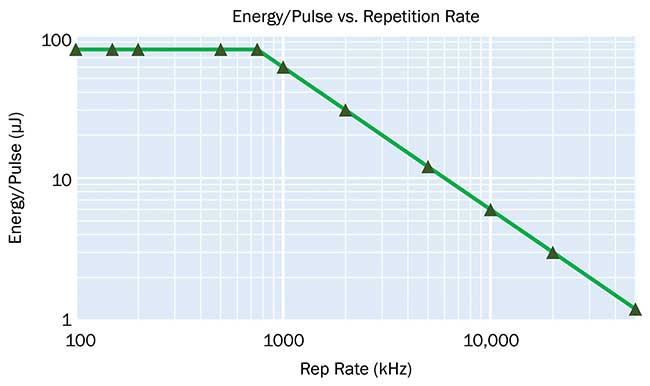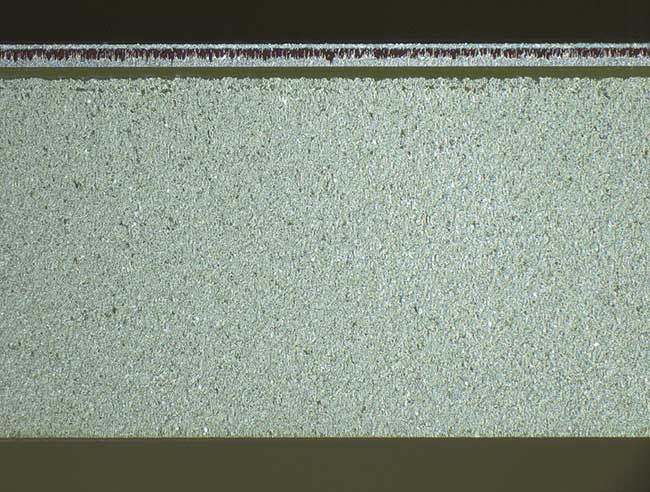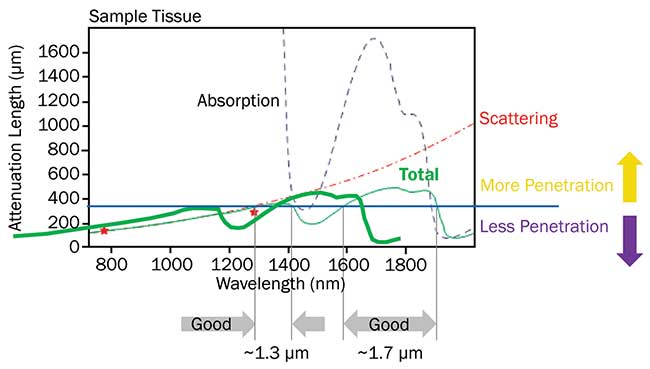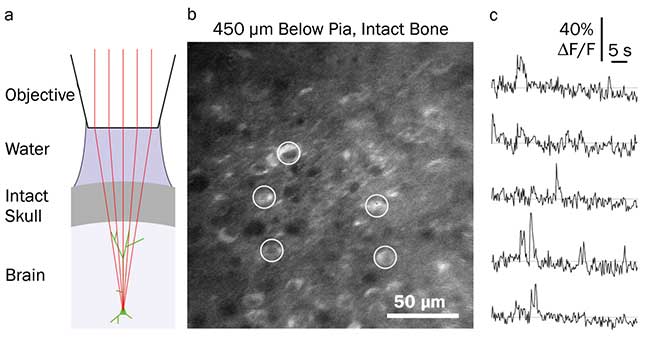Advances in this power-scalable technology are having an impact on industrial applications and scientific research.
MICHAEL LAHA, MARCO ARRIGONI AND JOSEPH HENRICH, COHERENT INC.
Ytterbium fiber laser amplifiers encompass one of the most dynamic areas in femtosecond lasers. Recent advances in power and speed are opening doors in scientific research and materials processing, impacting diverse fields spanning multiphoton imaging in neuroscience research to cutting OLEDs on glass substrates.
Ytterbium-doped optical materials have several advantages as a gain medium for ultrafast lasers, making them complementary to titanium:sapphire (Ti:sapphire) in scientific applications and Nd:YAG in industrial uses. Ytterbium has a wide gain bandwidth enabling mode-locked performance in the femtosecond regime, unlike neodymium, which is limited to only picosecond pulse widths.
In contrast to Ti:sapphire, ytterbium can be pumped directly by high-power laser diodes at a wavelength around 976 nm. Equally important, ytterbium can be incorporated in glass fibers. Fibers alleviate the challenge of thermal cooling and enable simple architecture without Pockels cells, which are needed in a bulk regenerative amplifier. Fibers can be doped and pumped in a way that allows gain saturation even at very high repetition rates. The only caveat is that nonlinearities resulting from the high fluence must be addressed. So while amplifiers using bulk gain materials are typically limited to hundreds of kHz, ytterbium fiber amplifiers can operate at up to tens of MHz.
Despite this unique combination of theoretical advantages, commercial ytterbium fiber-based lasers have only become available in recent years because several practical challenges (related to nonlinear effects caused by high peak power in the gain fiber) had to be solved. In particular, this caused a trade-off between power and pulse width in early ytterbium fiber oscillators. But, in response to application requirements, laser manufacturers have been able to develop high-power, mode-locked oscillators with 50 to 150 pulse widths, and higher-energy, amplified systems with 200- to 350-fs pulse durations.
MOPAs: High power, fast repetition
The time-proven route to high power with low noise is to use a master oscillator/power amplifier (MOPA) configuration. Several femtosecond MOPAs based on ytterbium fiber are now available (an example is the Monaco series from Coherent). Here, the oscillator is followed by a pulse picker to select the repetition rate of the pulses to be amplified in the sequential single-stage, cladding-pumped fiber amplifier. Unlike lasers based on ytterbium-doped bulk material, this fiber arrangement enables very flexible operation, from single pulses up to 50 MHz. Moreover, the total output power is virtually unaffected by changes in the pulse rate up to several MHz; doubling the pulse rate only cuts the pulse energy by 50 percent (Figure 1). The pulsing flexibility also supports so-called seeder burst mode — a group of two to five pulses at full energy and separated by the native repetition rate of the seed laser. This mode is very useful in many industrial applications, especially for thicker substrates. This type of laser amplifier also provides a flexible pulse width; the output pulses can be smoothly adjusted by the operator from <350 fs to >10 ps. This is beneficial for industrial applications and for microscopy applications to compensate for dispersion in the beam delivery system. The dynamic nature of this new area of laser technology means the specifications for these amplifiers are changing rapidly. For example, currently, the Monaco power is 60 W, which is the equivalent of 80 µJ pulse energy at a repetition rate of 0.75 MHz.

Figure 1. In the latest ytterbium fiber-based master oscillator/power amplifier sources, the total output power is virtually unaffected by changes in the pulse rate up to several MHz. Courtesy of Coherent.
These new ytterbium fiber amplifiers provide the ultimate combination of cutting-edge scientific performance with industrial reliability and longevity, and are therefore simultaneously finding applications on the lab table and the manufacturing floor.
Minimizing HAZ
For materials processing applications, high peak power, femtosecond-regime laser pulse widths are well known to produce a reduced heat-affected zone (HAZ) and a lower ablation threshold compared to longer pulse widths. This enables high-precision processing of a wide range of metal, semiconductor and organic materials. The combination of short pulse width and high repetition rate from the latest ytterbium fiber amplifiers make them ideal for high-speed, cost-effective cutting of plastic and polymer thin films, silicon wafer scribing and strengthened glass cutting. And because femtosecond laser processing is usually highly nonlinear, it is largely independent of material linear absorption characteristics. This type of laser source is especially useful for micromachining inhomogeneous, composite substrates that incorporate both “delicate” and “tough” materials, which are finding increasing use in microelectronic and display fabrication.
One such composite is polyimide on glass, a common combination used in OLED substrates. Filamentation cutting is an effective technique for cutting glass display substrates. This utilizes the high peak intensity created by a focused ultrafast laser to generate a stable, self-maintaining filament that extends over several millimeters in depth through an optically transparent material. The filament generates a precise defect in the material. The relative movement of the workpiece with respect to the laser beam can then be used to produce cuts with unmatched edge quality and no residual stress, which is particularly important for touch screens. It can also readily cut curves of varying geometries and radii of curvature. In addition, the typical filament diameter is in the range of 0.5 to 1 µm, enabling very high-precision cutting.
Until recently, all commercial versions of this cutting technique have utilized picosecond lasers. Several display manufacturers now make extensive use of these systems, which can cleave virtually any glass type at speeds up to 2 m/s and glass thicknesses up to 10 mm.
However, one limitation in some applications is that these picosecond systems are not completely material neutral. Cutting mixed layer substrates, such as polyimide on glass and metal on glass, often requires an additional laser process to cut the nonglass layer with the requisite high-quality edge.
Until now, femtosecond lasers have not been employed in filamentation applications because of their higher cost and lower power as compared to picosecond lasers. But this new generation of ytterbium fiber amplifiers has effectively addressed both of these issues, enabling the material neutrality to be fully evaluated for cutting mixed layers. Results obtained by engineers at Coherent’s applications laboratory show that they can cut glass up to several millimeters in thickness by utilizing seeder burst mode. The brief spacing (>20 ns) between individual pulses creates a material interaction proportional to the entire burst energy rather than the energy of a single pulse.

Figure 2. The femtosecond output of ytterbium fiber amplifiers is ideal for cutting structured transparent materials up to 3 mm thick. This is an edge view of 20 µm of polyimide on 0.5 mm glass, cut with a femtosecond laser with 40 W of average power and a pulse width ~350 fs. Courtesy of Coherent.
Most importantly, they have demonstrated that by careful process optimization, layered substrates with two or more dissimilar materials can be completely cut in a single pass with superior edge quality, virtually no residual edge stress and no HAZ in the “delicate” layers (Figure 2). For example, these studies show that the laser can cut >20 µm of polyimide on 0.5 mm of glass at a speed of 500 mm/s with a typical edge roughness of Ra = 0.35 µm.
Three-photon microscopy
For scientific research applications, femtosecond lasers and amplifiers based on Ti:sapphire are the benchmark for tunable, sub-50-fs, millijoule-class applications; their performances, taken individually or in combination, are still unmatched by Yb-based products. However, ytterbium lasers already provide higher average powers and repetition rate flexibility than Ti:sapphire. The gap between the two technologies continues to narrow.
The combination of high power and high repetition rates is ideal for nonlinear imaging applications when complemented with tunable parametric generation devices. Those characteristics meet the emerging demand for long-wavelength pulses to support deep imaging in live tissues using three-photon excitation of probes and fluorescent proteins. The main interest in deeper multiphoton microscopy is coming from neuroscience. Two-photon methods using Ti:sapphire lasers in the 850- to 1050-nm window are used extensively to study the function of interconnected neurons in the mouse cerebral cortex, which has a thickness of about 1 mm. However, these methods cannot penetrate much farther than 1 mm into live tissue because of absorption and scattering losses, which limits applicability to other mammals.
To probe farther into the mouse neocortex and apply the techniques to larger laboratory animals, which have thicker cortex layers, alternate techniques must be employed.
Several research groups have identified three-photon excitation at longer wavelengths as a means for deeper imaging. Specifically, there are two wavelength regions that enable greater penetration depth, centered at 1300 nm and 1700 nm (Figure 3).

Figure 3. The penetration depth for ultrafast lasers in live brain tissue is limited by a combination of scattering and absorption. There are two optimum penetration windows centered at 1300 and 1700 nm. Courtesy of Coherent/Prof. Chris Xu, Cornell University.
The 1300-nm window is ideal for three-photon excitation of transgenic probes based on green fluorescent proteins, and the 1700-nm wavelength is a good match for three-photon excitation of long wavelength probes based on red fluorescent proteins. Three-photon imaging also offers the advantage of lower background noise from out-of-plane fluorescence, and the longer wavelengths can penetrate thin bone tissue.
Three-photon excitation requires high energy at these wavelengths, and imaging requires high repetition rate. Legacy Ti:sapphire-based systems cannot provide this combination, but a new tunable type of optical parametric amplifier (OPA) delivers ideal performance when pumped by a ytterbium fiber amplifier.
An example is the Opera-F, which provides continuous tuning from 1200 to 2500 nm, power up to 1 W, repetition rates up to 1 MHz, and pulse widths as short as 50 fs. The short pulse width ensures high peak power and efficient three-photon excitation.
This combination is being used to perform 3D imaging by a research team led by Jack Waters, Ph.D., at the Allen Institute in Seattle. Waters’ group is studying the role of acetylcholine release in mouse brains, with the aim of imaging as much of the cortex as possible to see if the acetylcholine is localized or global. This is not possible using an implanted glass window.
Use of 1300-nm laser light transmits through the cranium while covering a large area of the cortex (Figure 4).

Figure 4. Allen Institute image of calcium imaging through intact mouse skull. Schematic of preparation without acrylic or coverslip (a). Temporal mean projection from an Emx1-IRES-Cre;CaMk2a-tTA;Ai94 mouse at 10-Hz frame rate, 3P excitation at 1300 nm through an intact ~300-µm-thick skull. Microscope focused 450 µm below pia (b). Spontaneous calcium transients from GCaMP-expressing somata (c) (circles in panel B). Courtesy of Allen Institute.
Powerful femtosecond ytterbium fiber amplifiers have only become commercially available in the past few years. But the future for these sources is bright, with applications that benefit from their unique performance in both the scientific and industrial arenas. Moreover, as the performance is further expanded, a corresponding increase in the applications space will naturally follow.
Meet the authors
Marco Arrigoni is director of strategic marketing at Coherent Inc., responsible for lasers and their applications that address scientific research; email: [email protected].
Mike LaHa is the product manager for the Monaco laser at Coherent Inc. He has over 25 years of experience in applications and marketing within the laser industry; email: [email protected].
Joe Henrich is the senior product line manager for ultrafast amplifiers and OPAs at Coherent Inc. He holds a Ph.D. from Ohio State University; email: [email protected].